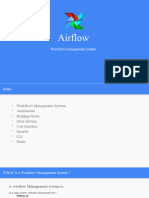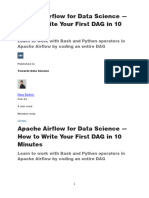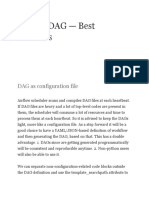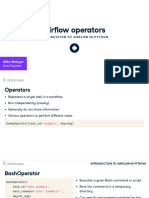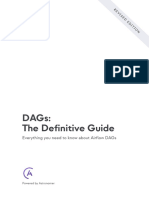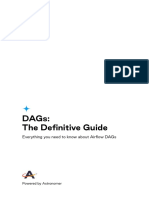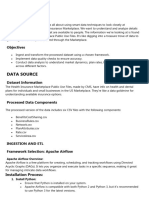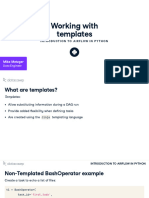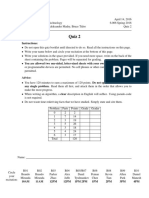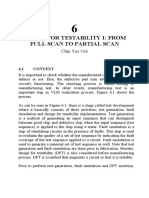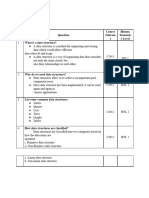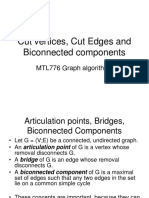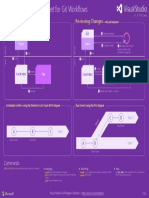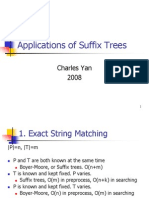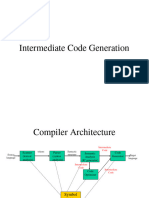DAG Structure and Operators
Introduction
Apache Airflow is a Python framework that helps create workflows using multiple technologies using
both CLI and a user-friendly WebUI. An Apache Airflow Directed Acyclic Graph (DAG) is a Python
program where you define the tasks and the pipeline with the order in which the tasks will be executed.
Airflow operator for task definition
Airflow offers a wide range of operators, including many that are built into the core or are provided by
pre-installed providers. Some popular core operators include:
BashOperator - executes a bash command
PythonOperator - calls an arbitrary Python function
EmailOperator - sends an email
The other core operators available include:
BaseBranchOperator - A base class for creating operators with branching functionality
BranchDateTimeOperator
EmptyOperator - Operator that does nothing
GenericTransfer - Moves data from on database connection to another.
LatestOnlyOperator - Skip tasks that are not running during the most recent schedule interval.
TriggerDagRunOperator - Triggers a DAG run for a specified dag_id.
Besides these, there are also many community provided operators. Some of the popular and useful ones
are:
HttpOperator
MySqlOperator
PostgresOperator
MsSqlOperator
� OracleOperator
JdbcOperator
DockerOperator
HiveOperator
S3FileTransformOperator
PrestoToMySqlOperator
SlackAPIOperator
In addition to operators, you also have sensors and decorators that allow you to combine bash and
Python.
� Anatomy of a DAG
A DAG
consists
of these
logical
blocks.
Imports
DAG Arguments
DAG Definition
Task Definitions
Task Pipeline
1. # import the libraries
2. from datetime import timedelta
3. # The DAG object; we'll need this to instantiate a DAG
4. from airflow.models import DAG
5.
6. # Operators; you need this to write tasks!
7. from airflow.operators.bash_operator import BashOperator
8. from airflow.operators.python import PythonOperator
9. from airflow.operators.email import EmailOperator
Copied!
DAG Arguments
1. #defining DAG arguments
2. # You can override them on a per-task basis during operator initialization
3. default_args = {
4. 'owner': 'Your name',
5. 'start_date': days_ago(0),
�6. 'email': ['youemail@somemail.com'],
7. 'retries': 1,
8. 'retry_delay': timedelta(minutes=5),
9. }
DAG arguments are like the initial settings for the DAG.
The above settings mention:
The owner name
When this DAG should run from: days_ago(0) means today
The email address where the alerts are sent to
The number of retries in case of failure
The time delay between retries
The other options that you can include are:
'queue': The name of the queue the task should be a part of
'pool': The pool that this task should use
'email_on_failure': Whether an email should be sent to the owner on failure
'email_on_retry': Whether an email should be sent to the owner on retry
'priority_weight': Priority weight of this task against other tasks.
'end_date': End date for the task
'wait_for_downstream': Boolean value indicating whether it should wait for downtime
'sla': Time by which the task should have succeeded. This can be a timedelta object
'execution_timeout': Time limit for running the task. This can be a timedelta object
'on_failure_callback': Some function, or list of functions to call on failure
'on_success_callback': Some function, or list of functions to call on success
'on_retry_callback': Another function, or list of functions to call on retry
'sla_miss_callback': Yet another function, or list of functions when 'sla' is missed
'on_skipped_callback': Some function to call when the task is skipped
'trigger_rule': Defines the rule by which the generated task gets triggered
DAG definition block example
1. # define the DAG
2. dag = DAG(
3. dag_id='unique_id_for_DAG',
4. default_args=default_args,
5. description='A simple description of what the DAG does',
6. schedule_interval=timedelta(days=1),
7. )
Here we are creating a variable named dag by instantiating the DAG class with the following
parameters:
� unique_id_for_DAG is the ID of the DAG. This is what you see on the web console. This is what you can
use to trigger the DAG using a TriggerDagRunOperator.
You are passing the dictionary default_args , in which all the defaults are defined.
description helps us in understanding what this DAG does.
schedule_interval tells us how frequently this DAG runs. In this case every day. ( days=1 ).
task definitions block example
The tasks can be defined using any of the operators that have been imported.
11# define the tasks
1. # define a task with BashOperator
2. task1 = BashOperator(
3. task_id='unique_task_id',
4. bash_command='<some bashcommand>',
5. dag=dag,
6. )
7.
8. # define a task with PythonOperator
9. task2 = PythonOperator(
10. task_id='bash_task',
11. python_callable=<the python function to be called>,
12. dag=dag,
13. )
14.
15. # define a task with EmailOperator
16. task3 = EmailOperator(
17. task_id='mail_task',
18. to='recipient@example.com',
19. subject='Airflow Email Operator example',
20. html_content='<p>This is a test email sent from Airflow.</p>',
21. dag=dag,
22. )
� A task is defined using:
A task_id which is a string that helps in identifying the task
The dag this task belongs to
The actual task to be performed
o The bash command it represents in case of BashOperator
o The Python callable function in case of a PythonOperator
o Details of the sender, subject of the mail and the mail text as HTML in case of EmailOperator
task pipeline block example
1. # task pipeline
2. task1 >> task2 >> task3
Copied!
You can also use upstream and downstream to define the pipeline. For example:
1. task1.set_downstream(task2)
2. task3.set_upstream(task2)
Copied!
Task pipeline helps us to organize the order of tasks. In the example, the task task1 must run first,
followed by task2 , followed by the task task3 .






